List of all types of wild cats, with pictures and facts on every species in the cat family Felidae.
Types of wild cats include big cat species belonging to the subfamily Pantherinae, including the lion, tiger, jaguar, leopard and snow leopard; and members of the subfamily Felinae, including the cheetah, cougar, lynx, bobcat, ocelot, margay, caracal, serval, fishing cat and Pallas's cat.
On this page are pictures and facts on all 41 currently recognized cat species, which includes 40 wild cat species and the domestic cat, Felis catus.
Wild Cats List Index
- Click on the cat’s name in the list above to see further information on that species...
- ... or continue scrolling to browse the entire wild cat list.
Felidae: The Cat Family
There are 41 cat species in the cat family Felidae. Felidae contains two subfamilies: Pantherinae and Felinae.
- Pantherinae is home to mainly large, powerful wild cats such as the tiger, lion, jaguar, leopard, and snow leopard.
- Felinae includes species that are typically medium-sized or smaller, including the lynxes, ocelot, margay, caracal, serval and Pallas's cat. Two members of Felinae – namely the mountain lion and cheetah, are as large as or larger than some members of Pantherinae.
The cat family Felidae is part of a larger group of animals, the order Carnivora, which is also home to all dogs, bears, seals, weasels and several other groups of mainly predatory mammals.
Big Cats
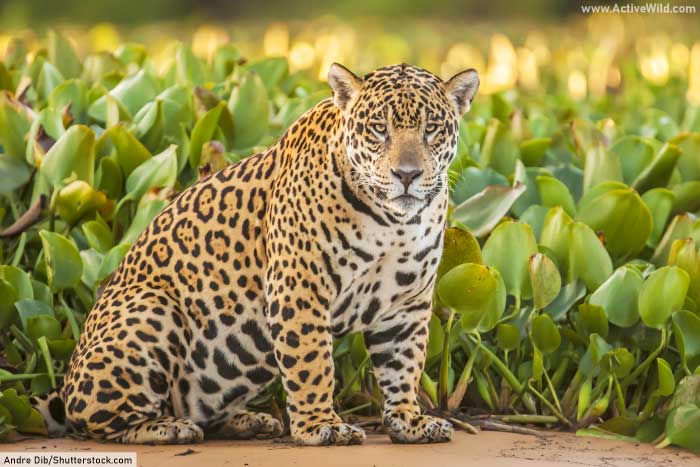
The term “big cats” is an informal grouping that refers to the tiger, lion, jaguar, leopard, and snow leopard, and which is often expanded to include the two largest members of the subfamily Felinae: the cougar (also known as the mountain lion or puma) and the cheetah.
You can find out more about big cats on this page: What Is A Big Cat?
How Many Types Of Wild Cats Are There?
The cat family Felidae contains 41 species: 40 types of wild cats and the domestic cat. The exact number of living cat species is debated, with some authorities recognizing either more, or fewer, species.
On this page we have used the findings of the International Union for the Conservation of Nature (IUCN) Cat Specialists Group’s study: A Revised Taxonomy of the Felidae, which lists 41 different cat species. (Source)
At the time of writing, the Catalogue of life lists 42 cat species (source), while the Mammal Species of the World database contains 40 species (source).
Differences in these lists is due to closely-related species being regarded either as separate species or subspecies of the same species.
For example, the Catalogue of Life currently lists the Pantanal cat as being a distinct species, whereas the Cat Specialist Group lists it as a subspecies of the Pampas cat.
Cats
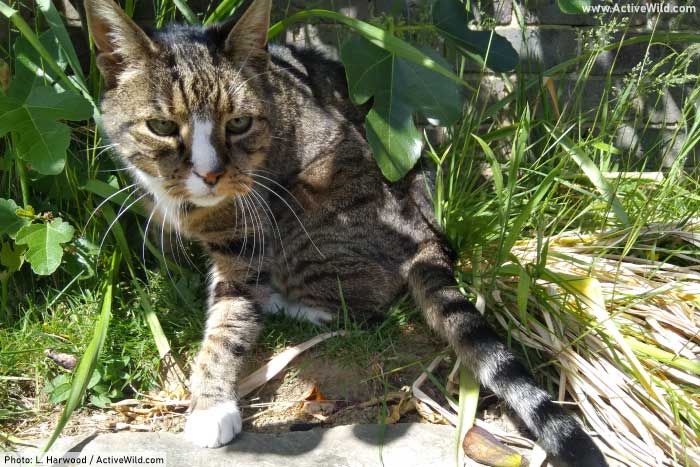
Cats are mammals belonging to the family Felidae, which is part of the order Carnivora. Wild cats are found in the Americas, Asia, Africa and Europe.
All cats are carnivores, and several species are apex predators with no natural predators of their own.
You can see more apex predators on this page: Apex Predators
Characteristics of cats include retractable claws, sharp teeth, powerful jaws, good night vision and acute hearing. Cats are highly agile and often hunt by stealth, creeping close to their prey before pouncing.
Many types of wild cats are proficient climbers, often entering trees in order to rest, hunt, or seek refuge from predators.
Wild cats are solitary, territorial animals. Of the 41 cat species, only the lion typically lives and hunts in groups.
The first wild cats appeared around 30 million years ago. Each of the 41 living cat species in the list below is believed to be descended from a common ancestor that lived in Asia between 11.6 and 5.3 million years ago.
Sadly, many wild cat species are either endangered or threatened. The conservation status (where known) of every wild cat species has been included in the list below. This information is taken from the IUCN Red List. (Source)
Complete List Of All Wild Cat Species With Pictures & Facts
African Golden Cat
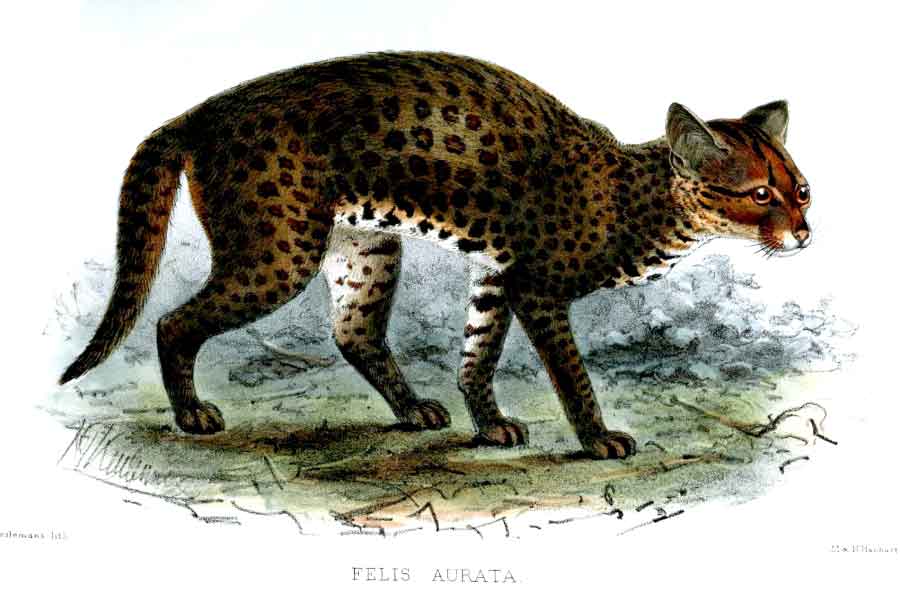
- Scientific name: Caracal aurata
- Subfamily: Felinae
- Where found: Africa
- Conservation status: Vulnerable
The African golden cat lives deep in the rainforests of central Africa. The species, a close relation of the caracal and serval, is around twice the size of a domestic cat. Its fur ranges in color from gold-brown to silver-grey, and is covered in faint spots.
African Wildcat
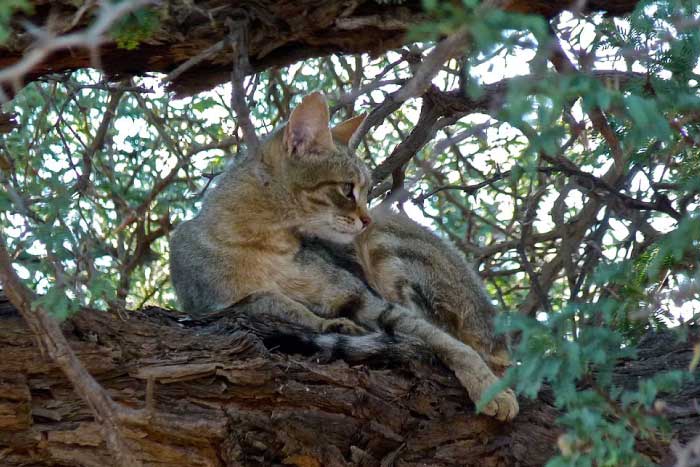
- Scientific name: Felis lybica
- Subfamily: Felinae
- Where found: Africa, Asia
- Conservation status: Least Concern
Once considered a subspecies of the wildcat Felis silvestris, the African wildcat is now considered to be a separate species, thought to have diverged from its European cousin around 173,000 years ago.
The species is typically pale gray with faint stripes and a white underside. It is smaller, and has shorter fur, than the wildcat. Its ears often have small tufts.
The African wildcat is found throughout much of Africa and also in Western Asia. It is typically found in hill and mountainous regions, but this adaptable cat can survive in a wide range of habitats.
Andean Mountain Cat
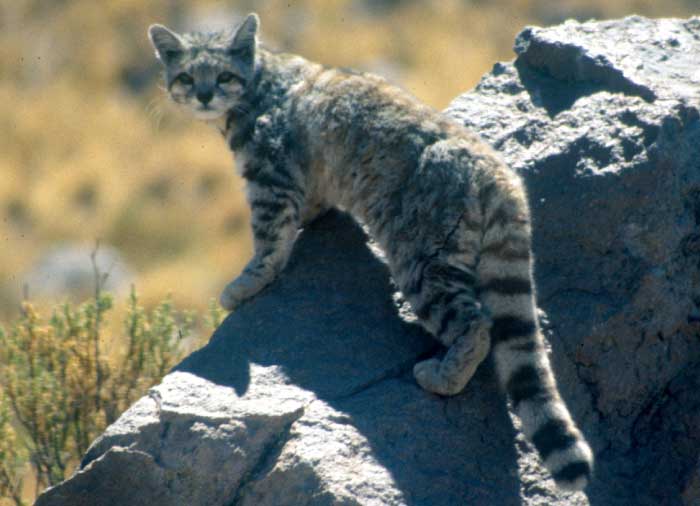
- Scientific name: Leopardus jacobita
- Subfamily: Felinae
- Where found: South America
- Conservation status: Endangered
Found in mountainous regions of Peru, Chile, Bolivia and Argentina, the Andean mountain cat is a small, sandy-grey cat with faint stripes on its body and darker stripes on its tail.
The species is endangered due to hunting, habitat loss and the loss of prey animals. Its population, which is estimated to include fewer than 1,500 mature individuals, continues to decline.
This secretive South American wild cat is very rarely seen. Its main prey is the mountain viscacha (Lagidium viscacia), a chinchilla-like rodent.
Asian Golden Cat
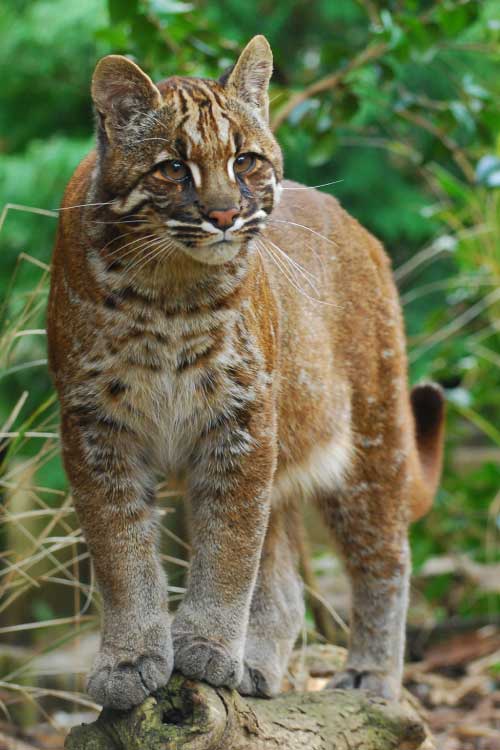
- Other names: Temminck's cat; Asiatic golden cat
- Scientific name: Catopuma temminckii
- Subfamily: Felinae
- Where found: Southeast Asia
- Conservation status: Near Threatened
The Asian golden cat is a mid-sized wild cat found in Southeast Asia. (Countries in which the species is present include India, Cambodia, China, Bhutan, Myanmar, Thailand, Malaysia and Indonesia.)
The Asian golden cat is over twice the size of a domestic cat. Its coat is typically golden-red, but a wide range of other color varieties are known. Some individuals have ocelot-like rosettes. The face is distinctively-marked with white patches and black lines on the cheeks and forehead.
Typically found in forests, the Asian golden cat is also inhabits savanna, shrubland and grassland habitats.
The Asian golden cat’s conservation rating is Near Threatened. The species’ population is believed to be in decline.
Bay Cat
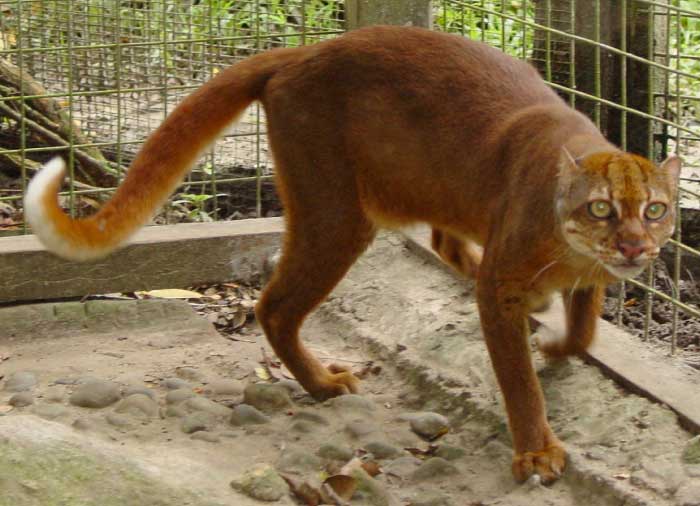
- Other names: Borneo bay cat; Bornean bay cat
- Scientific name: Catopuma badia
- Subfamily: Felinae
- Where found: Borneo
- Conservation status: Endangered
The Bay cat is a small, endangered wild cat endemic to the Southeast Asian island of Borneo. It is closely related to the Asiatic golden cat.
The Bay cat is smaller than its near-relative, growing to a maximum of around 4kg / 9 lb (around the size of a domestic cat). Its coat is a deep red-brown color, with faint spots on the body and patches of white on the face.
The Bay cat’s population consists of around 2,200 mature adults, and is thought to be decreasing. The forest-living species is one of the many victims of the widespread deforestation that has occurred in Borneo in recent times.
Black-Footed Cat
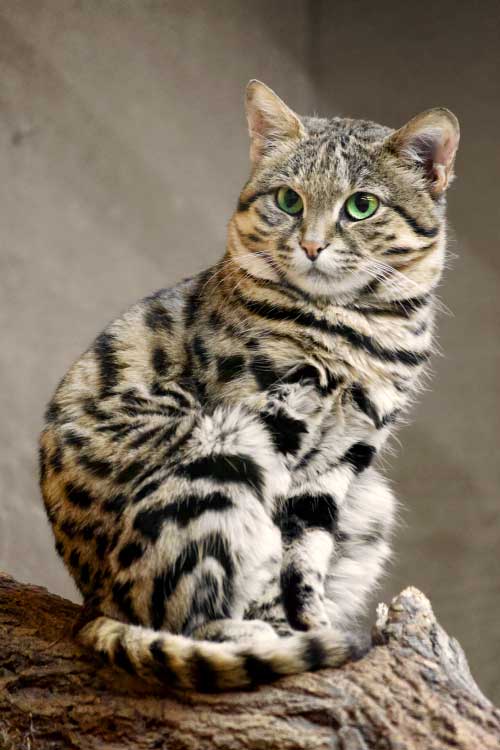
- Alternative name: Small-spotted cat
- Scientific name: Felis nigripes
- Subfamily: Felinae
- Where found: Southern Africa
- Conservation status: Vulnerable
The black footed cat is one of the world’s smallest wild cat species, and the smallest found in Africa. With a maximum weight of around 2.5 kg (5.4 lb.), the species is smaller than a domestic cat, and substantially smaller than the African wildcat – both of which are close relatives.
The black footed cat has a pale-yellow coat marked with thick black stripes; the tail is ringed with a black tip. Surprisingly, only the soles of its feet are black.
The black footed cat inhabits savanna, grassland and desert habitats in southern Africa. The species is present in Namibia, South Africa and Botswana, and is thought to also be present in Zimbabwe and southern Angola.
Bobcat
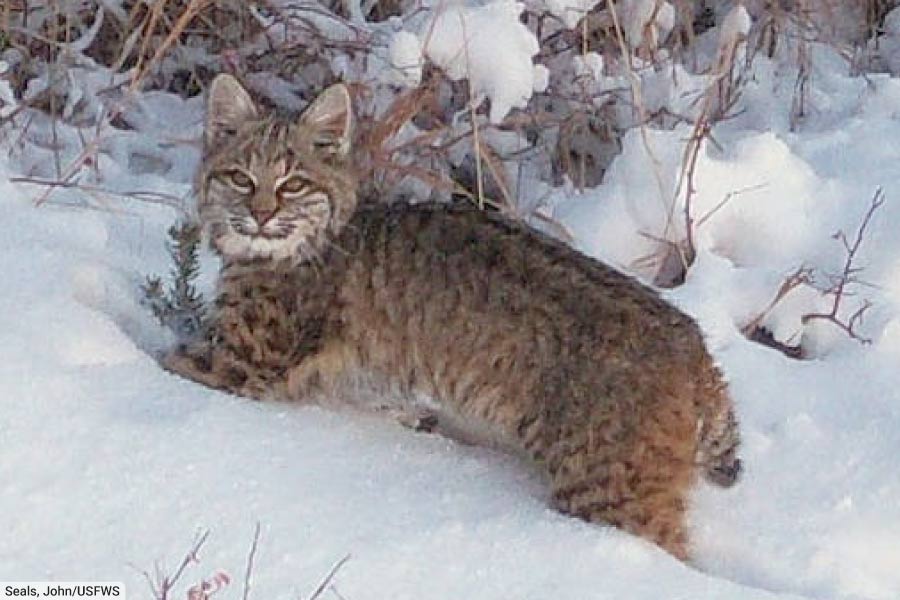
- Scientific name: Lynx rufus
- Subfamily: Felinae
- Where found: North America
- Conservation status: Least Concern
The bobcat is a mid-sized wild cat found in North America. Its range covers southern Canada to northern Mexico, and the species is found throughout the USA.
The bobcat’s closest relations in the cat family are the lynxes. It is the only member of the genus Lynx not to have the word ‘lynx’ in its name.
With an average weight of around 8.2 kg (18.2 lb.), the bobcat is around twice the size of a typical domestic cat. The bobcat’s characteristic short tail is between 9 and 20 cm (3.5 and 8 in) in length.
The color of a bobcat’s coat ranges from reddish-brown to gray-brown. The coat is marked with dark spots and streaks, and the animal’s undersides are pale.
Bobcats from the north are generally darker in color than those living in desert regions in the south.
The bobcat is most active at dawn and dusk. It preys mainly on rabbits and hares, but this opportunistic hunter will take most small to medium-sized animals that it is able to overcome.
- You can find out more about the bobcat on this page: Bobcat Facts
Canada Lynx
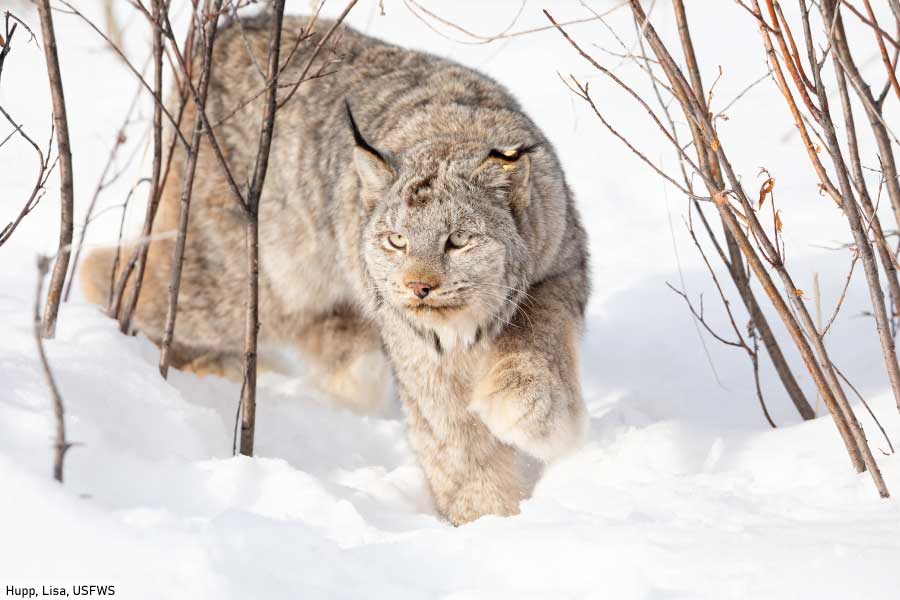
- Alternative name: Canadian lynx
- Scientific name: Lynx canadensis
- Subfamily: Felinae
- Where found: North America
- Conservation status: Least Concern
The Canada lynx is similar in size and appearance to the Bobcat, to which it is closely related. The Canada lynx can be recognized by its large furry feet, black ear tufts, and the patch of black at the end of its short tail. It is slightly larger than the Bobcat and at least twice the size of a domestic cat.
The habitat of the Canada lynx is often covered with deep snow. The species’ big paws and long hind legs allow it to hunt its favored prey – the snowshoe hare – in these conditions.
Caracal
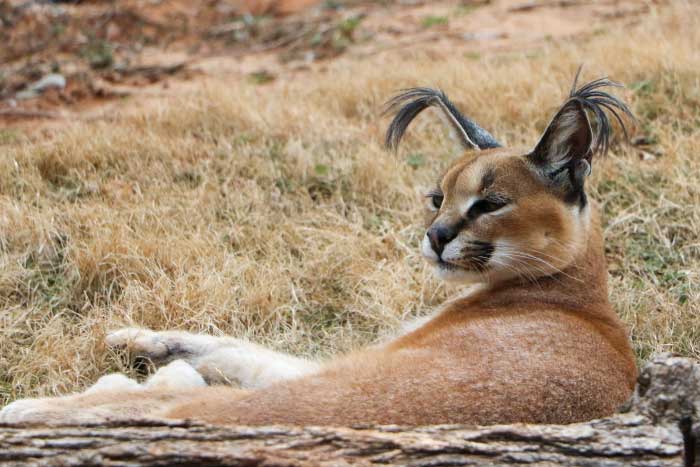
- Alternate name: Desert lynx
- Scientific name: Caracal caracal
- Subfamily: Felinae
- Where found: Africa, West Asia
- Conservation status: Least Concern
The caracal is a mid-sized wild cat with a short, pale gold coat and distinctive long, black ear-tufts. The species’ name comes from the Turkish for ‘black ear’. Its ear tufts, which resemble those of a lynx, are also responsible for its alternate name of ‘desert lynx’.
Ancient Egyptians used to hunt with domesticated caracals.
The caracal is found in Africa, the Middle East and India. It is fairly common, particularly in southern and eastern Africa.
- You can find more information on the caracal on this page: Caracal Facts
Cheetah
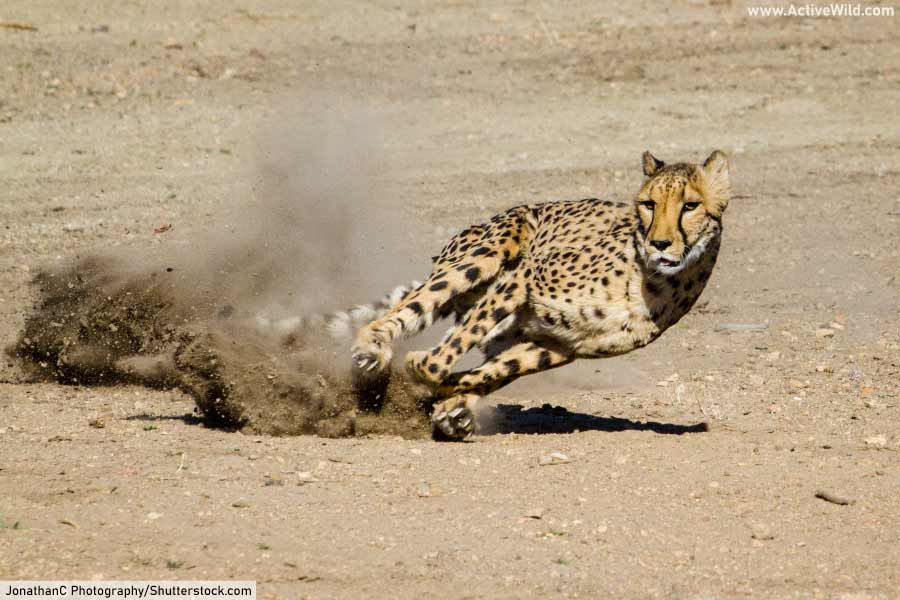
- Scientific name: Acinonyx jubatus
- Subfamily: Felinae
- Where found: Africa
- Conservation status: Vulnerable
The Cheetah is the world’s fastest land animal, capable of reaching speeds of up to 61 mph / 98 km/h (some even estimate the cheetah's maximum speed to be closer to 75 mph (120 km/h).
This African cat species' awesome speed, acceleration and maneuverability allow it to hunt the fast-moving antelopes that form the bulk of its diet.
The Cheetah is a tall, slim cat with long legs and a small head. It has a pale gold coat marked with small dark spots, and pale undersides. Its tail, which reaches a maximum length of around 80 cm (31 in), provides balance during the animal’s high-speed chases.
Cheetahs live in small, localized populations in sub-Saharan Africa (the area south of the Sahara desert). There are fewer than 7,000 adult cheetahs in the wild, and the species’ population is decreasing.
- You can find out more about Cheetahs on this page: Cheetah Facts
Chinese Mountain Cat
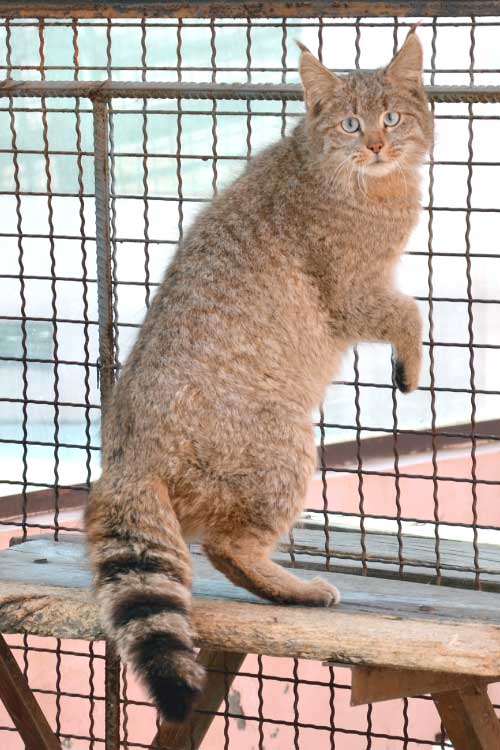
- Alternative names: Chinese desert cat; Chinese steppe cat
- Scientific name: Felis bieti
- Subfamily: Felinae
- Where found: Western China
- Conservation status: Vulnerable
The Chinese Mountain cat is a mid-sized wild cat found only in western China. Its coat is pale yellow-grey with faint stripes, and its tail has black rings.
This secretive cat is active at night, preying on small vertebrates such as rodents and birds. It lives in forests and grasslands in mountainous regions.
Clouded Leopard
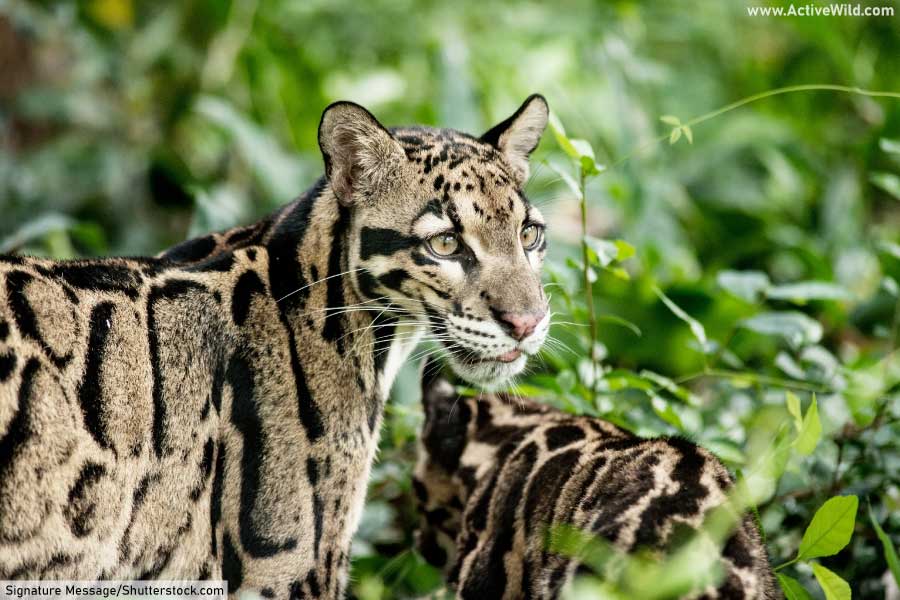
- Alternative name: Mainland clouded leopard
- Scientific name: Neofelis nebulosa
- Subfamily: Pantherinae
- Where found: Asia
- Conservation status: Vulnerable
This medium-large Asian wild cat is named for its cloud-like markings. It is found on mainland Southeast Asia, and is sometimes called the mainland clouded leopard to distinguish it from the closely-related Sunda clouded leopard.
The clouded leopard has among the longest canine teeth in relation to body size of any cat. This forest cat has a long tail, which is used for balance and support when the cat is climbing in the trees.
A skillful climber, the clouded leopard rests in the trees during the day, coming down to the forest floor at night to hunt.
- You can find out more about the clouded leopard on this page: Clouded Leopard Facts
Cougar
- See Mountain Lion
Domestic Cat

- Scientific name: Felis catus
- Subfamily: Felinae
- Where found: All continents except Antarctica
- Conservation status: Domestic
The domestic cat is thought to have originated from wildcats that were tamed around 9,000 to 10,000 years ago. Around 95 million domestic cats are kept in the USA, making cats the country's second most popular pet, after fish.
Despite its domestication, the cat remains an effective predator of small mammals and birds. Sadly, a downside of widespread cat ownership is the negative effect these predators can have on local wildlife.
Eurasian Lynx

- Scientific name: Lynx lynx
- Subfamily: Felinae
- Where found: Europe; Asia
- Conservation status: Least Concern
The Eurasian lynx has a large range that includes south-eastern and central Europe, together with parts of Asia, including China, India, Iran and Pakistan. It has a number of subspecies, including the northern lynx, Balkan lynx and Siberian lynx.
The Eurasian lynx is a medium-sized wild cat. It is the largest lynx species, weighing between 18 and 30 kg (40 and 66 lb.). It has a red-brown spotted coat, with paler undersides.
Like all lynxes, the Eurasian lynx has tufted ears, long powerful legs, and a short ‘bobbed’ tail.
- You can find out more about Eurasian lynxes on this page: Eurasian Lynx Facts
European Wildcat
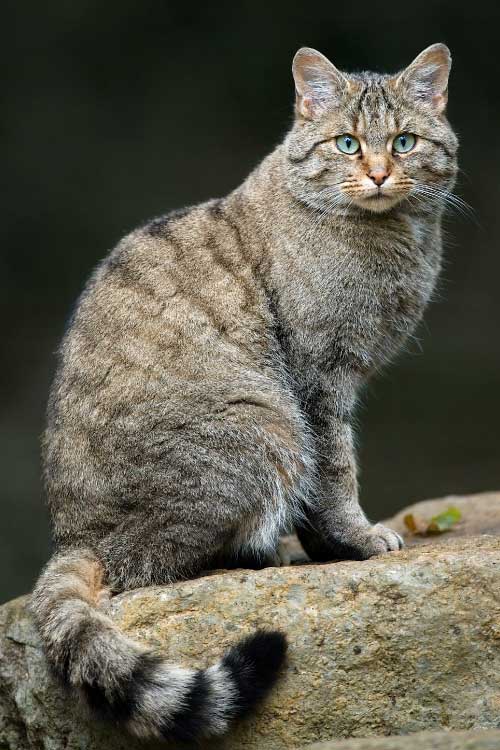
- Scientific name: Felis silvestris
- Subfamily: Felinae
- Where found: Europe
- Conservation status: Least Concern
The European wildcat is a small cat that is widely distributed across Europe. It is usually found in forests, typically avoiding human settlements.
There is much debate of the classification of the wildcat. It is genetically very similar to the domestic cat and other species in the genus Felis, which includes species such as the jungle cat, sand cat and black footed cat.
Some biologists consider the domestic cat to be a subspecies of wildcat. The wildcat and domestic cat can breed, and in some areas this can be a threat to the continued existence of pure wildcats.
Most wildcats are slightly larger and stockier than domestic cats. The species has gray or pale gold fur, with faint spots or stripes. Its tail is bushy with black rings.
Fishing Cat
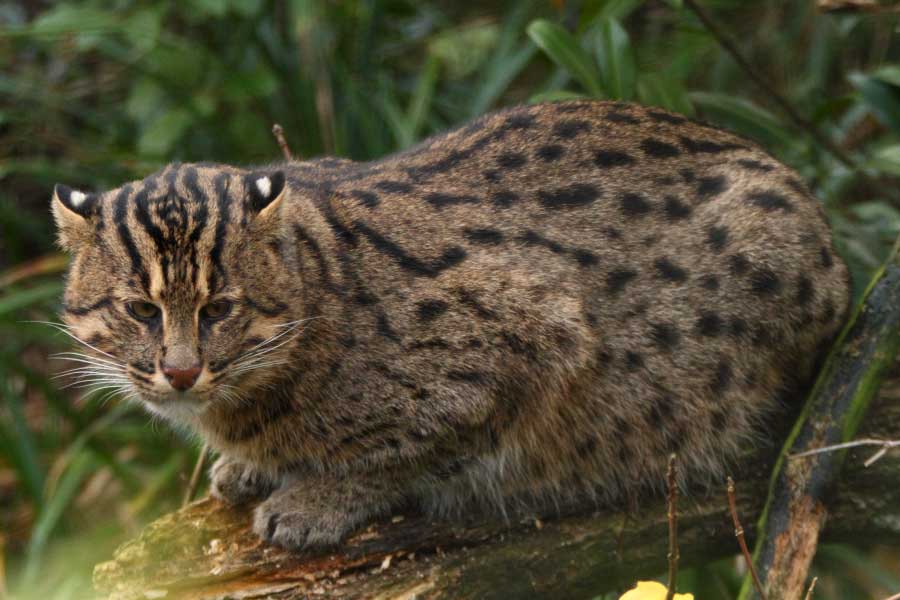
- Scientific name: Prionailurus viverrinus
- Subfamily: Felinae
- Where found: Asia
- Conservation status: Vulnerable
The fishing cat is a mid-sized species of wild cat found in South and Southeast Asia. It has a grey, spotted coat, and a striped face and head.
Closely associated with water, the fishing cat lives near lakes, swamps and mangroves. It is capable of swimming large distances. The species’ diet consists of fish, together with small mammals, birds and other small animals.
Flat-Headed Cat
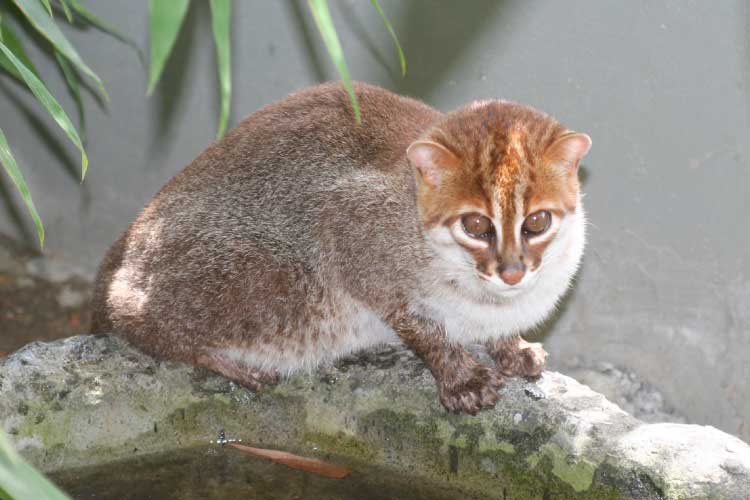
- Scientific name: Prionailurus planiceps
- Subfamily: Felinae
- Where found: Southeast Asia
- Conservation status: Endangered
The Flat-Headed Cat is a small cat found in the Thai-Malay Peninsula, and on the islands of Borneo and Sumatra.
The species is easily distinguished from other small wild cat species by its long, ‘flattened’ head and small, rounded ears. Its body is grey and unmarked. The flat-headed cat uses its long teeth to capture fish, its preferred food.
The population of this endangered cat species currently numbers around 2,500 mature individuals, and is thought to be decreasing.
Geoffroy’s Cat
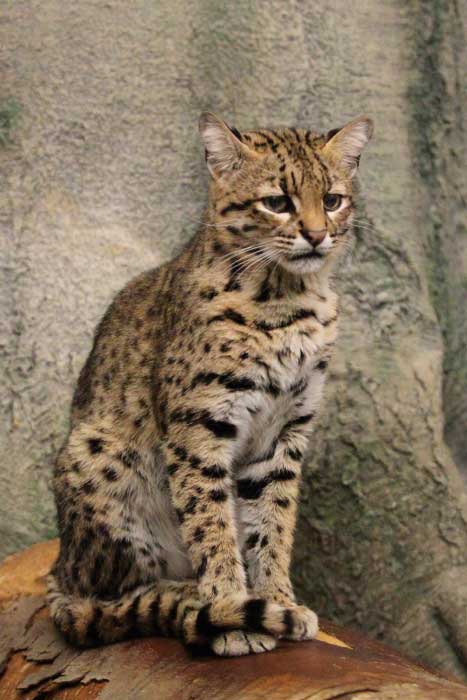
- Scientific name: Leopardus geoffroyi
- Subfamily: Felinae
- Where found: Southern South America
- Conservation status: Least Concern
Geoffroy’s Cat was named after the French naturalist Geoffroy St. Hilaire. This small wild cat is about the size of a domestic cat. It is a pale gold color, with dark spots and a ringed tail. Its coat becomes less golden, and greyer, the further south it is found.
Geoffroy’s Cat is found in several South American countries, including Chile and Argentina. Its range stretches from southern Bolivia in the north, to the Straits of Magellan in the south.
Typical habitat includes woodlands, savannas, and the Pampas, a vast lowland grassland system.
The species is not currently threatened and its population is stable.
Iberian Lynx
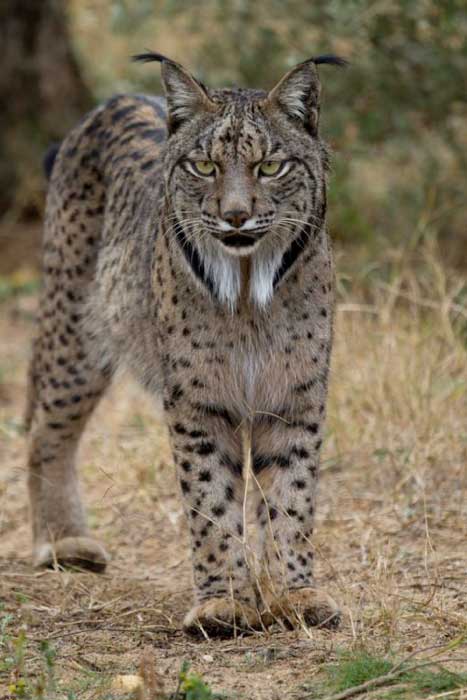
- Scientific name: Lynx pardinus
- Subfamily: Felinae
- Where found: Iberian Peninsula
- Conservation status: Endangered
The Iberian Lynx is species of cat found in southwestern Spain. It is one of the world’s most endangered cats. In 2002 only 52 mature individuals remained in the wild.
Like other lynxes, the Iberian Lynx has tufted ears, long legs, a short tail, and long fur around the front of its neck. The Iberian Lynx is two to three times the weight of a domestic cat and smaller than the Eurasian lynx.
Measures taken to protect the Iberian lynx include captive breeding programs and habitat preservation. As a result of this conservation work, the species’ population is now increasing, with 156 mature individuals being counted in a 2012 study.
Jaguar

- Scientific name: Panthera onca
- Subfamily: Pantherinae
- Where found: South America
- Conservation status: Near Threatened
The Jaguar is the largest cat found in the Americas, and the third-largest species of cat in the world (only the tiger and lion are larger). It is a large, powerful apex predator, capable of preying on large animals such as caiman, green anacondas and tapirs.
The jaguar has a golden-yellow coat, marked with black rosettes. Large males can weigh up to 96 kg (211 lb.).
The Jaguar is threatened by habitat fragmentation.
- You can find out more about Jaguars on this page: Jaguar Facts
Jaguarundi
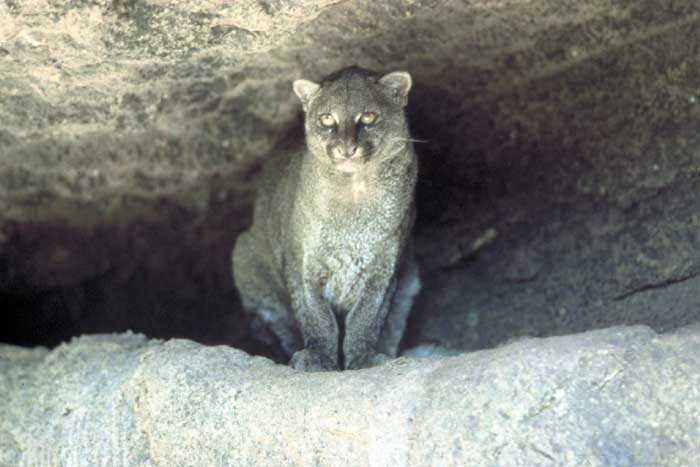
- Scientific name: Herpailurus yagouaroundi
- Subfamily: Felinae
- Where found: South America; Central America
- Conservation status: Least Concern
The jaguarundi is a small wild cat species native to the Americas. It has a slender, elongated body with short legs and a long, tapering tail.
The coat of the jaguarundi is variable in color, ranging from reddish-brown to grayish-black, with individuals sometimes appearing almost entirely black. The face is rounded with small, rounded ears, and large eyes.
These agile hunters are known for their adaptability, thriving in a variety of habitats, including forests, grasslands, and scrublands. Jaguarundis are primarily solitary and have a diet consisting of small mammals, birds, and insects.
Jaguarundis are occasionally seen as far north as Texas.
- You can find out more about the jaguarundi on this page: Jaguarundi Facts
Jungle Cat
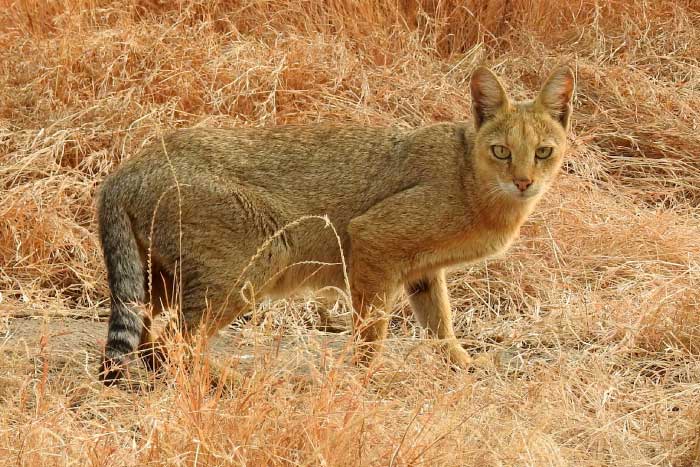
- Other names: swamp cat; reed cat
- Scientific name: Felis chaus
- Subfamily: Felinae
- Where found: Asia
- Conservation status: Least Concern
The jungle cat is a mid-sized wild cat found throughout much of Asia. It has a pale, grey-brown unmarked coat and a faintly ringed tail. It stands around 40 cm (16 in) tall and weighs between 4–16 kg (9–35 lb.).
The jungle cat is associated with water, and is more likely to be found in swamps and wetlands with dense vegetation rather than rainforests.
A versatile predator, the jungle cat preys on a variety of small mammals, birds, and reptiles.
Kodkod
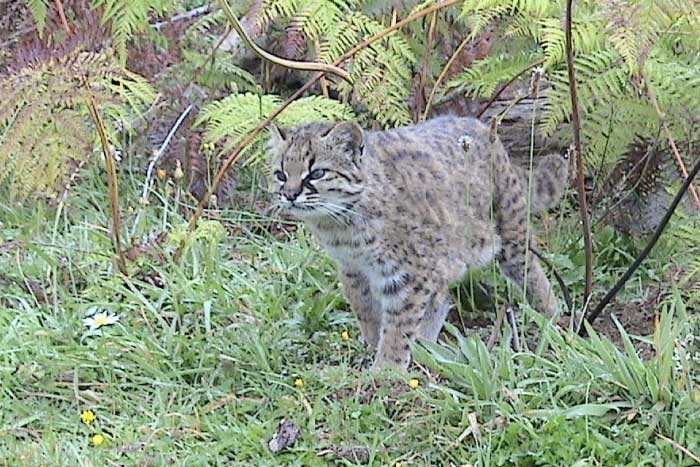
- Alternative name: Guiña
- Scientific name: Leopardus guigna
- Subfamily: Felinae
- Where found: South America
- Conservation status: Vulnerable
The kodkod, or Guiña, is the smallest wild cat species of the Americas. With a maximum weight of just 2.5 kg (5.5 lb.), it is significantly smaller than a domestic cat.
The kodkod’s coat is gray-gold with black spots. Its thick tail is marked with black rings.
The species is found in temperate rainforests in Chile and parts of Argentina. Although a capable climber, it usually hunts on the forest floor. Rodents form the bulk of its diet, but it will also take a wide range of small vertebrates.
The Kodkod’s natural habitat has become severely fragmented and the species is further threatened by hunting.
Leopard
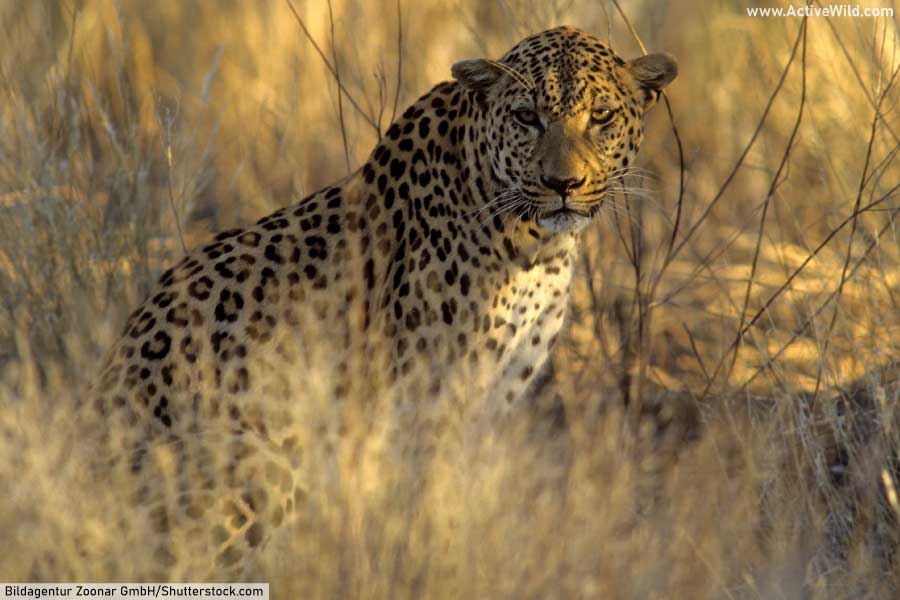
- Scientific name: Panthera pardus
- Subfamily: Pantherinae
- Where found: Africa; Asia
- Conservation status: Vulnerable
The Leopard is a species of big cat found in sub-Saharan Africa, Asia, and parts of Russia. It is similar in appearance to the Jaguar but slightly smaller and less bulky. Its pale golden coat is covered in distinctive rosettes which, unlike those of the Jaguar, are not filled with spots.
The leopard is known for its strength, and will carry a kill up a tree to prevent it being stolen by hyenas.
- You can find out more about leopards on this page: Leopard Facts
Leopard Cat
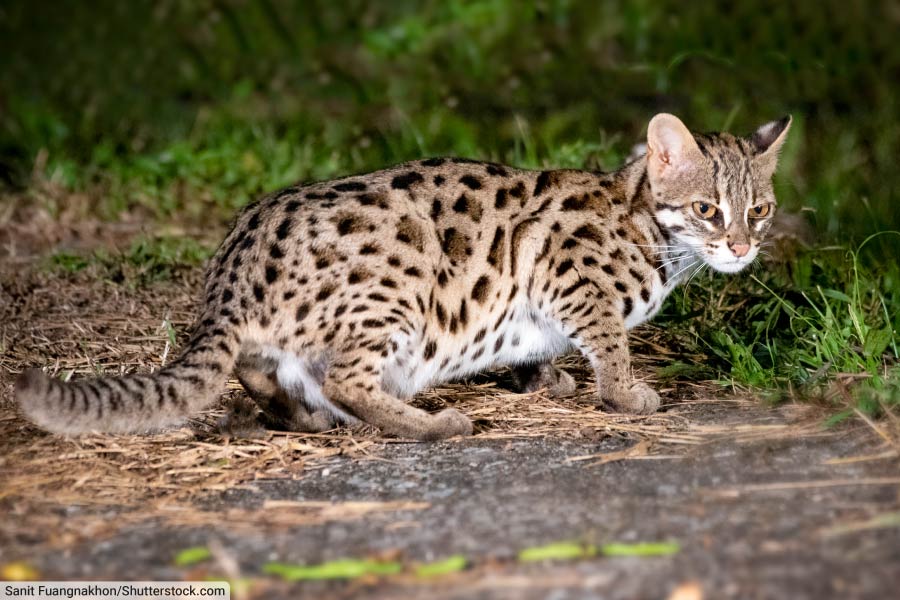
- Scientific name: Prionailurus bengalensis
- Subfamily: Felinae
- Where found: Asia
- Conservation status: Least Concern
The leopard cat is a small wild cat that is widely distributed throughout Asia. Countries in which it is found include China, Russia, India and the Philippines.
The species is found in a range of forest habitats, including rainforests and temperate broadleaf forests. It is also found in grasslands, but usually prefers those with some tree cover. It feeds mainly on mice, rats, and other small vertebrates.
The leopard cat is similar in size to a domestic cat. The patchy spots that cover its body give it the appearance of a miniature leopard, hence the species’ name. The color of its coat ranges from gold to grey, depending on where it is found.
The Iriomote cat is a subspecies of leopard cat that is endemic to the Japanese island of Iriomote. It is found in forests and mangroves.
Lion
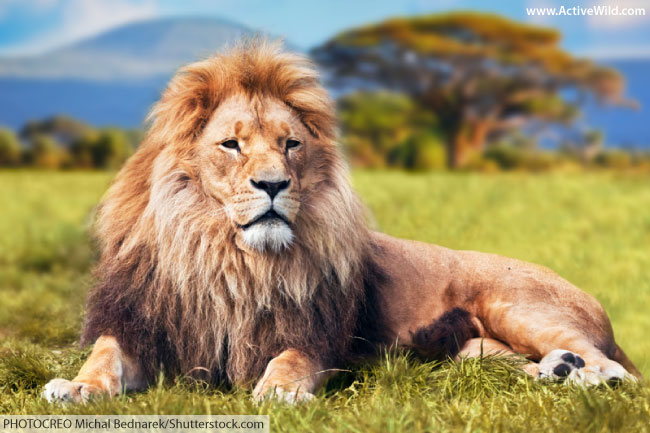
- Scientific name: Panthera leo
- Subfamily: Pantherinae
- Where found: Africa; Asia
- Conservation status: Vulnerable
One of the best-known types of wild cats, the lion is the world’s second-largest cat species; only the tiger is bigger.
The lion is the only truly social cat. Unlike other wild cats, which are typically solitary, lions live in groups known as "prides".
Lions are large, muscular wild cats with a distinctive tawny-colored coat, which in some individuals may be slightly darker or lighter. Lions are known for their majestic mane of the male, which can range from blond to dark brown.
Lions are found in eastern and southern Africa, and in two very small, isolated groups in India. They are threatened by indiscriminate killing by local people (often because of the lion’s perceived threat to livestock), who leave poisoned carcasses for the lions to eat. Lions are also hunted for their body parts, which are used in traditional Asian medicine.
- You can find out more about lions on this page: Lion Facts
Marbled Cat
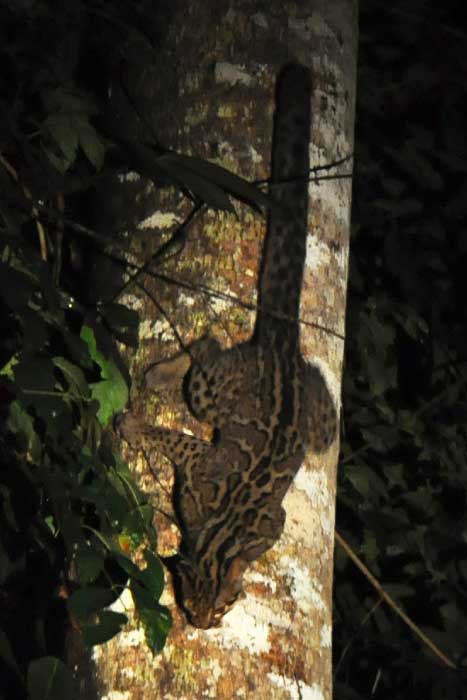
- Scientific name: Pardofelis marmorata
- Subfamily: Felinae
- Where found: Asia
- Conservation status: Near Threatened
Similar in size to a domestic cat, the marbled cat is closely related to the Asian golden cat and the bay cat. The species is found in southern and southeastern Asia.
The marbled cat is brown-red in color with darker, cloud-like blotches. Its tail is as long again as its head and body. The long tail helps the cat to maintain its balance while climbing.
The species prefers pristine forest, and is threatened both by habitat loss and hunting. Its population is severely fragmented.
Margay
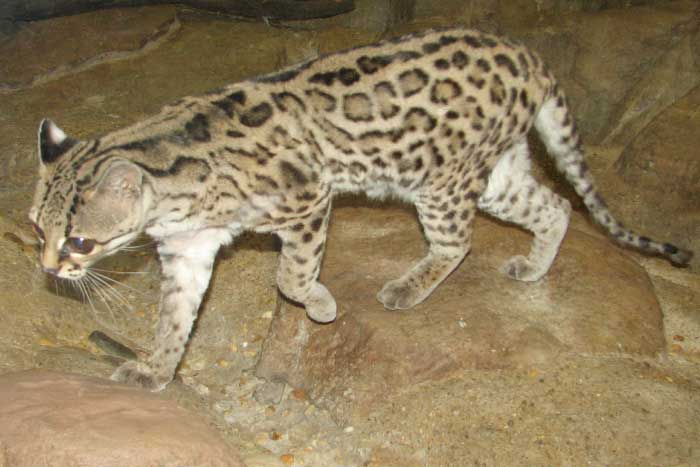
- Scientific name: Leopardus wiedii
- Subfamily: Felinae
- Where found: South America; Central America
- Conservation status: Near Threatened
The margay is a small south American type of wild cat. It is found in several countries in south and central America, including Brazil, Peru and Mexico.
With a pale-yellow coat and numerous black spots, the margay is similar in appearance to its close relative the ocelot, but is smaller, being similar in size to a domestic cat.
An excellent climber, the margay often rests in trees. However, it does most of its hunting on the ground.
Threats to the margay include habitat loss, illegal hunting for its skin and capture for the pet trade.
- You can find out more about the margay on this page: Margay Facts
Mountain Lion
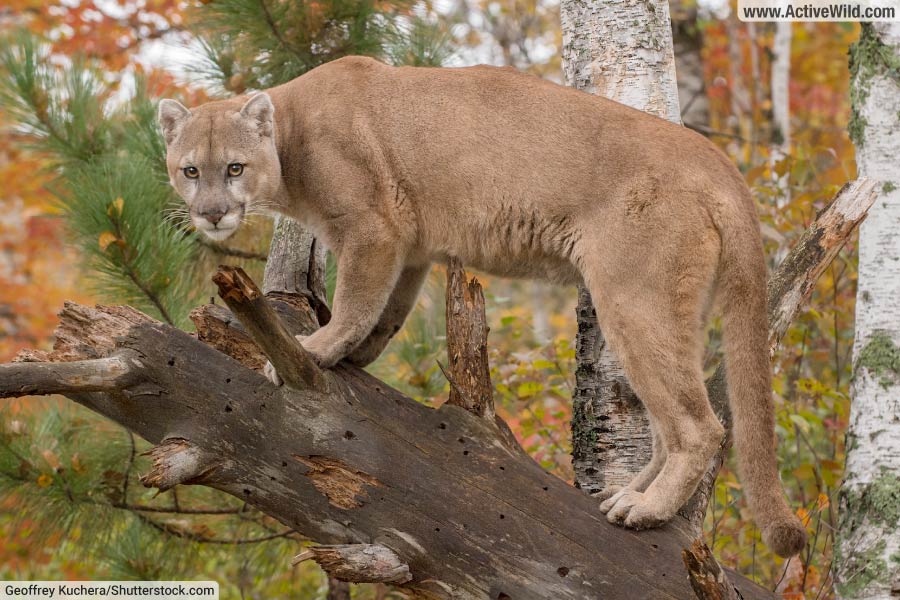
- Alternative names: puma, cougar, catamount
- Scientific name: Puma concolor
- Subfamily: Felinae
- Where found: North America; South America
- Conservation status: Least Concern
The mountain lion is a large wild cat found in both North and South America. The species is also commonly known as both the puma and the cougar.
The species’ large range stretches from northern Canada to the Andes in South America. It is found in a wide range of habitats, including forests, grasslands and deserts.
The mountain lion is the second-largest cat of the Americas (the Jaguar is the largest), and the fourth-largest of all cat species. Despite being (on average) larger than a leopard, the mountain lion is not considered to be a big cat, as it cannot roar.
The species is a stealthy ambush predator whose favored prey is deer. It will also prey on livestock.
- You can find out more about this American wild cat on this page: Puma Facts
Ocelot
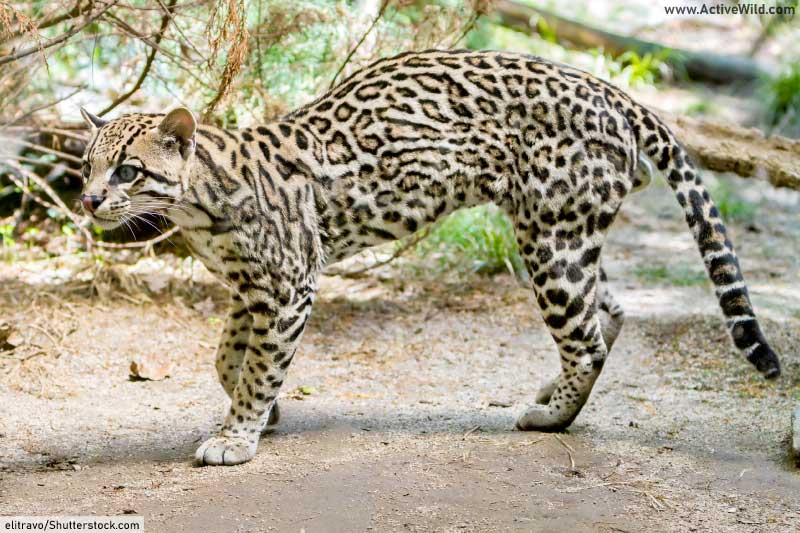
- Scientific name: Leopardus pardalis
- Subfamily: Felinae
- Where found: South America; Central America
- Conservation status: Least Concern
The ocelot is a striking, medium-sized wild cat found in south and central America. The species is occasionally sighted as far north as southern Texas. It inhabits various habitats, from dense rainforests to arid grasslands.
Around twice the size of a domestic cat, the ocelot has a slender, graceful body with a distinctive coat pattern, featuring a background of tawny or yellowish fur adorned with black rosettes and spots.
The ocelot is primarily nocturnal, preying on small mammals, birds, and reptiles.
- You can find out more about the Ocelot on this page: Ocelot Facts
Oncilla
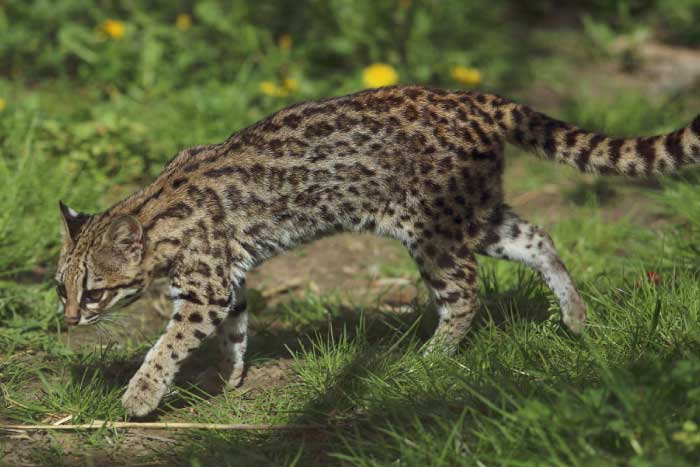
- Alternative names: northern tiger cat; little spotted cat; tigrillo
- Scientific name: Leopardus tigrinus
- Subfamily: Felinae
- Where found: South America
- Conservation status: Vulnerable
The oncilla, also known as the little spotted cat or tigrillo, is a small wild cat species native to Central and South America, closely related to the ocelot and margay. It possesses a petite, slender body with a dappled coat of rich tawny or grayish-brown fur adorned with distinctive dark spots and rosettes. The oncilla has large, expressive eyes, rounded ears, and a short tail with a dark rings.
These elusive and solitary hunters are mainly nocturnal, preying on small mammals, birds, and insects. Their elusive nature and cryptic appearance make them challenging to spot in their preferred habitats, which range from tropical rainforests to montane forests.
Pallas’s Cat
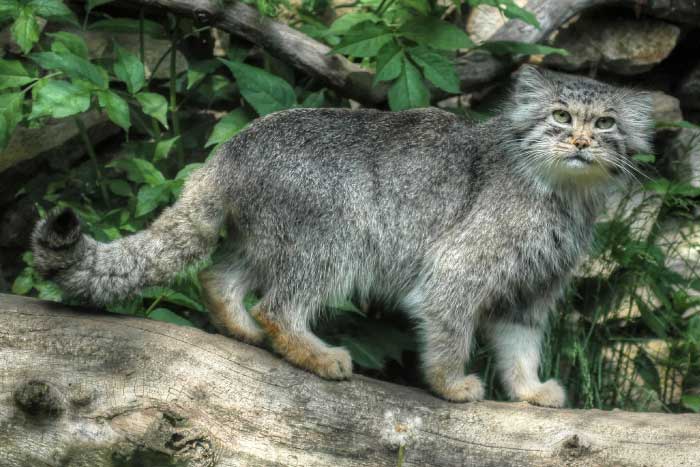
- Alternative name: Manul
- Scientific name: Otocolobus manul
- Subfamily: Felinae
- Where found: Central Asia
- Conservation status: Least Concern
Known for its distinctive appearance, Pallas's cat has a stocky body, short legs, and a flat, rounded face. Its fur is dense and covers a range of colors, from pale gray to yellowish-brown, marked by irregular dark spots and stripes, giving it a unique, almost comical appearance. Its ears are positioned low on the sides of its head, allowing it to keep a low profile when stalking its prey.
This Asian wild cat is similar in size to a domestic cat, weighing between 2.2 and 4.1 kg (5 and 9 lb.).
Pallas's cats are highly adapted to their harsh, cold environments and are skilled hunters, primarily preying on small mammals and birds. These solitary and elusive cats are well-suited to the challenging terrain of their high-altitude habitats.
Pampas Cat
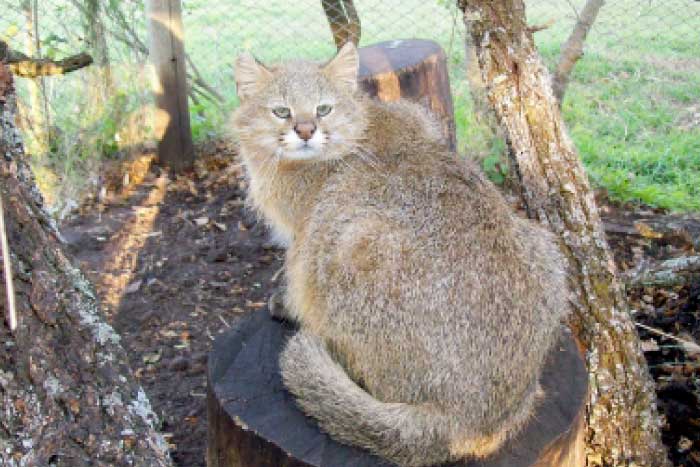
- Alternative names: Pantanal cat; Colocolo
- Scientific name: Leopardus colocolo
- Subfamily: Felinae
- Where found: South America
- Conservation status: Near Threatened
The pampas cat is a small wild cat species native to South America, particularly the grasslands and shrublands known as the pampas. It is present in Ecuador, Peru, Brazil, Bolivia, Chile, Paraguay, Uruguay, and Argentina.
The species has a slender, agile body with a coat that ranges from pale orange to silver-grey, adorned with subtle dark spots and stripes. Its face is round and it has distinctive ear tufts. The tail is short and often banded with dark rings. Most pampas cats weigh under 4 kg (8.8 lb.); less than a domestic cat.
These solitary and nocturnal hunters prey on small mammals, birds, and insects. They are expertly adapted to their grassland habitats and can be elusive.
Puma
- See Mountain Lion
Rusty-Spotted Cat
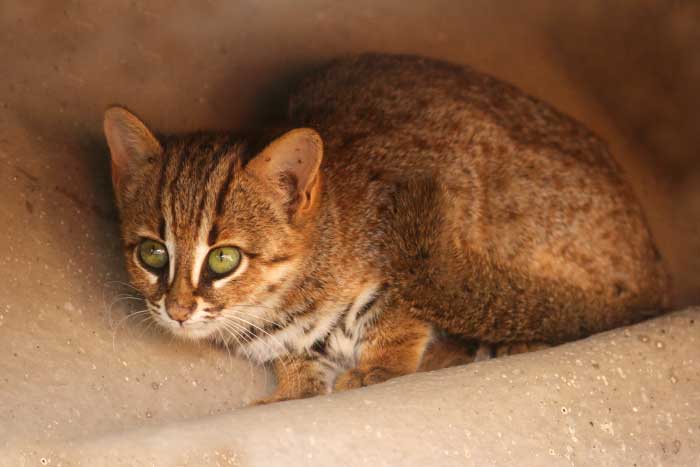
- Scientific name: Prionailurus rubiginosus
- Subfamily: Felinae
- Where found: Indian Subcontinent; Sri Lanka
- Conservation status: Near Threatened
The rusty-spotted cat is the world's smallest wild cat species, weighing between 0.9 and 1.6 kg (2.0 and 3.5 lb.), and reaching a maximum head-body length of 48 cm (19 in). A large tiger (the biggest wild cat species) is 200 times bigger than a rusty-spotted cat!
Native to India and Sri Lanka, this diminutive felid is characterized by a tiny, slender body, short legs, and a coat with a reddish-brown hue and distinctive rusty spots and stripes.
Rusty-spotted cats have round faces, large eyes, and a short tail marked with bands and a dark tip. These elusive and primarily nocturnal hunters feed mainly on small rodents. They thrive in a variety of habitats, from forests to grasslands, and their small size allows them to navigate the dense underbrush effectively.
Sand Cat
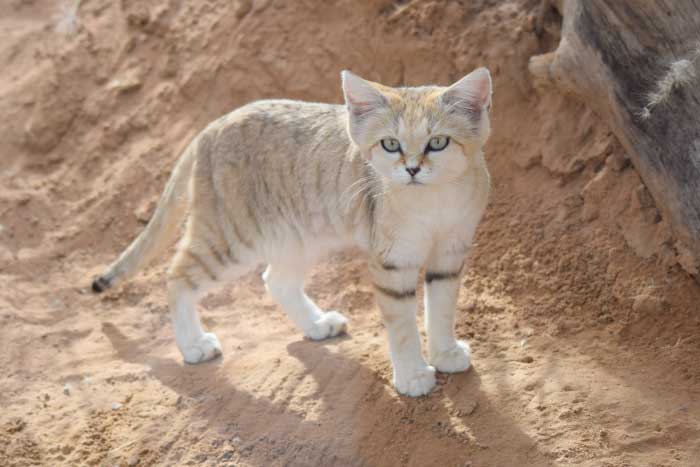
- Scientific name: Felis margarita
- Subfamily: Felinae
- Where found: Asia; North Africa
- Conservation status: Least Concern
The sand cat is a desert specialist that lives in arid regions of north Africa and southwest and central Asia.
Smaller than a domestic cat, the sand cat is a pale sandy color, with two distinctive black bands around its front legs and dark bands spreading outwards from its eyes.
The paws of the sand cat are covered in thick, stiff fur, allowing the cat to walk over hot sand. The species can obtain all of the water it needs from its prey, which consists mainly of small rodents. (It will also drink from a water source if one is available.) The sand cat is a fast digger, and will burrow into the sand in order to reach its prey.
The sand cat is mainly active at night. During the day, it shelters from the harsh desert sun in burrows or among rocks.
- You can find out more about sand cats on this page: Sand Cat Facts
Serval
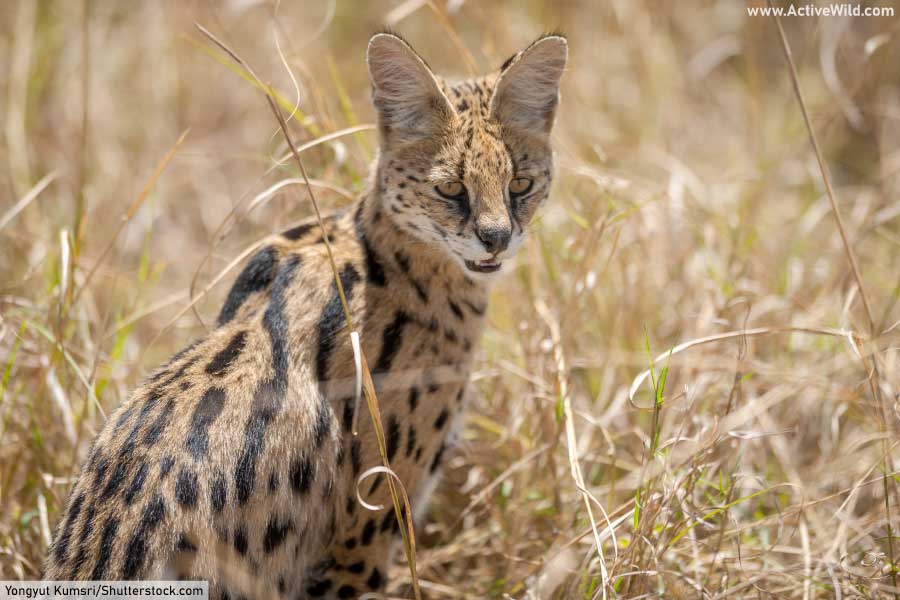
- Scientific name: Leptailurus serval
- Subfamily: Felinae
- Where found: Africa
- Conservation status: Least Concern
The serval is a mid-sized African species of wild cat. It is found mainly in Sub-Saharan Africa, where it inhabits a variety of habitats, but is absent from rainforests and deserts.
The serval’s coat is a pale sandy color and covered in large black spots, some of which merge into lines. For its size, the serval has the longest legs of all cats. Other distinguishing features include a small head and extremely large ears.
The serval preys mainly on small vertebrates such as rodents, but will also take animals as large as small antelopes.
The Serval has a wide range and is relatively common.
- You can find out more about the serval on this page: Serval Facts
Snow Leopard
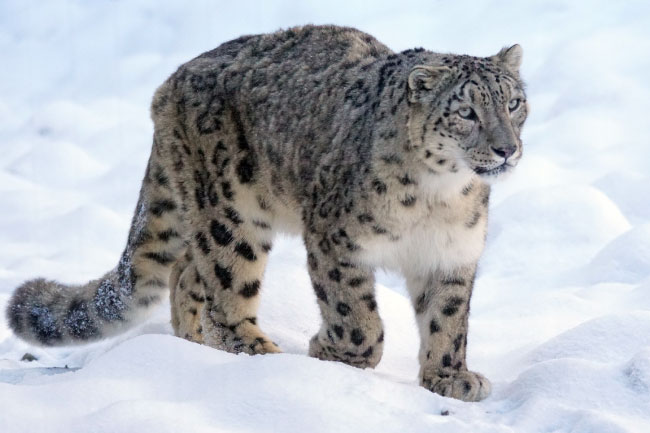
- Alternative name: Ounce
- Scientific name: Panthera uncia
- Subfamily: Pantherinae
- Where found: Asia
- Conservation status: Vulnerable
Despite its name, the snow leopard is more closely related to the tiger than the leopard.
This graceful and elusive wild cat is found in the mountains of central and south Asia. The regions in which it lives are covered in snow for at least part of the year.
The snow leopard has a pale yellow-white coat marked with dark rosettes. Its eyes are pale green / grey. The species' long, thick fur retains heat, and its large feet enable it to walk over snow without sinking.
It is estimated that there are fewer than 3,500 adult snow leopards in the wild. Threats to the species include habitat loss and hunting.
- You can find out more about the snow leopard on this page: Snow Leopard Facts
Southern Tiger Cat
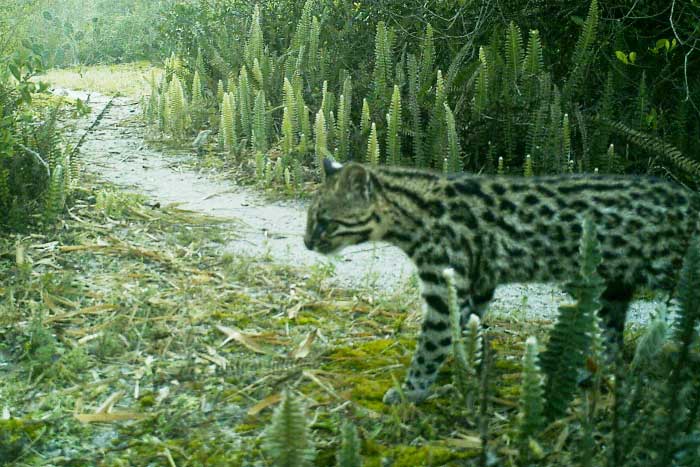
- Alternative name: Southern tigrina
- Scientific name: Leopardus guttulus
- Subfamily: Felinae
- Where found: South America
- Conservation status: Vulnerable
The southern tiger cat is a small wild cat found in brazil, eastern Paraguay and northern Argentina. Until recently (2013), it was considered to be a subspecies of oncilla.
The southern tiger cat has a yellow-brown coat marked with rosettes. It inhabits a range of habitats, including rainforests and savannas.
Sunda Clouded Leopard
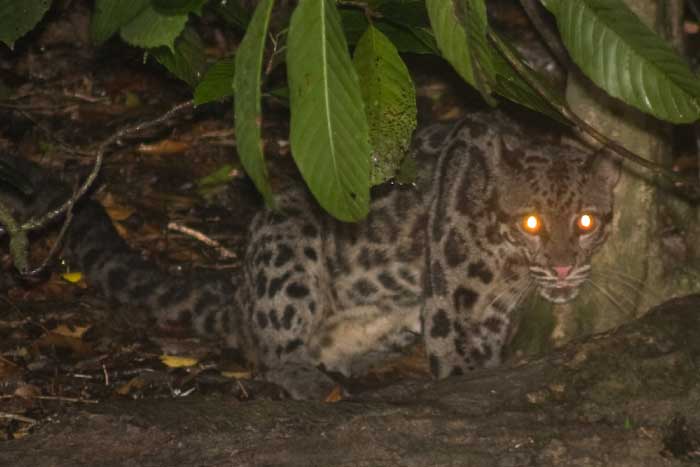
- Scientific name: Neofelis diardi
- Subfamily: Pantherinae
- Where found: Borneo; Sumatra; Other Southeast Asian islands
- Conservation status: Vulnerable
The Sunda clouded leopard was identified as being a separate species to the clouded leopard in 2006. The species is native to the Southeast Asian islands Sumatra and Borneo.
This elusive wild cat has a medium-sized, muscular body with a striking coat pattern consisting of large, cloud-like spots and rosettes on a golden-yellow to grayish background. This distinctive coat helps the Sunda clouded leopard blend seamlessly into the dense rainforests it inhabits.
Sunda clouded leopards are known for their large canines relative to their size. They are primarily solitary and nocturnal hunters, preying on various small to medium-sized mammals and birds. Their secretive nature and cryptic appearance make them a captivating and rarely seen species in their natural habitat.
There are around 4,500 Sunda clouded leopards of breeding age in the wild, a figure thought to be decreasing. The decline is due mainly to deforestation caused by logging and the conversion of forests into oil palm plantations.
Sunda Leopard Cat

- Scientific name: Prionailurus javanensis
- Subfamily: Felinae
- Where found: Southeast Asia
- Conservation status: Unassessed
The Sunda leopard cat is a small wild cat found on several Southeast Asian islands, including Borneo, Sumatra and Java. Until recently, it was considered a subspecies of the leopard cat found in mainland Asia.
The Sunda leopard cat has long legs and a slender body. Its fur is orange-brown with black spots, patches and lines. It inhabits a variety of forests, and may also be found in grasslands. It preys mainly on rodents.
Tiger
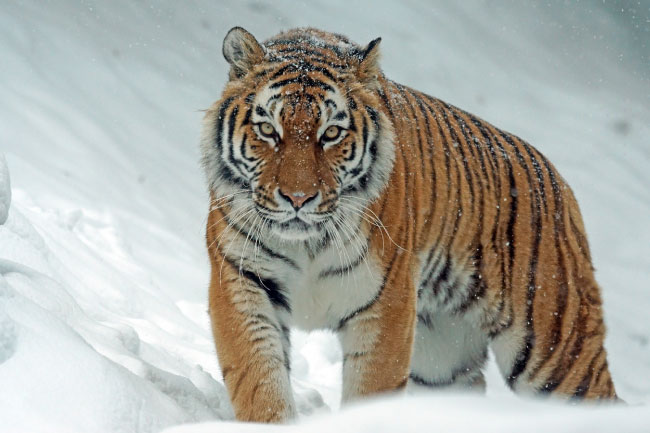
- Scientific name: Panthera tigris
- Subfamily: Pantherinae
- Where found: Asia
- Conservation status: Endangered
The tiger is the largest species of cat in the world. Large males can reach weights of over 350 kg / 770 lb. and have total body-tail lengths of 3.9m / 12.8 ft.
The tiger has a fragmented population across Asia, and is found in habitats as diverse as snow-covered Siberian forests and tropical mangrove swamps.
Despite the tiger being one of the world’s most recognizable animals, it is an endangered species. Only around 3,000 tigers of breeding age are left in the wild; there are currently more tigers in captivity than there are in the wild.
Biologists disagree over the number of tiger subspecies; recent research has identified just two subspecies: a mainland subspecies, and one found on the Greater Sunda Islands.
Other biologists believe that up to nine tiger subspecies exist, including well-known subspecies such as the Siberian Tiger and the Bengal Tiger.
- You can find out more about tigers on this page: Tiger Facts
Table Of All Species In The Cat Family Felidae
The table below contains information on all 40 types of wild cats and the domestic cat:
| English Name | Scientific Name | Subfamily | Lineage | Where Found | Conservation Status |
|---|---|---|---|---|---|
| African Golden Cat | Caracal aurata | Felinae | Caracal | Africa | Vulnerable |
| African Wildcat | Felis lybica | Felinae | Domestic Cat | Africa; Asia | Least Concern |
| Andean Mountain Cat | Leopardus jacobita | Felinae | Ocelot | South America | Endangered |
| Asian Golden Cat | Catopuma temminckii | Felinae | Bay Cat | Asia | Near Threatened |
| Bay Cat | Catopuma badia | Felinae | Bay Cat | Asia | Endangered |
| Black-Footed Cat | Felis nigripes | Felinae | Domestic Cat | Africa | Vulnerable |
| Bobcat | Lynx rufus | Felinae | Lynx | North America | Least Concern |
| Canada Lynx | Lynx canadensis | Felinae | Lynx | North America | Least Concern |
| Caracal | Caracal caracal | Felinae | Caracal | Africa; Asia | Least Concern |
| Cheetah | Acinonyx jubatus | Felinae | Puma | Africa | Vulnerable |
| Chinese Mountain Cat | Felis bieti | Felinae | Domestic Cat | Asia | Vulnerable |
| Clouded Leopard | Neofelis nebulosa | Pantherinae | Panthera | Asia | Vulnerable |
| Domestic Cat | Felis catus | Felinae | Domestic Cat | All continents except Antarctica | Domestic |
| Eurasian lynx | Lynx lynx | Felinae | Lynx | Europe | Least Concern |
| European Wildcat | Felis silvestris | Felinae | Domestic Cat | Europe | Least Concern |
| Fishing Cat | Prionailurus viverrinus | Felinae | Leopard Cat | Asia | Vulnerable |
| Flat-Headed Cat | Prionailurus planiceps | Felinae | Leopard Cat | Asia | Endangered |
| Geoffroy's Cat | Leopardus geoffroyi | Felinae | Ocelot | South America | Least Concern |
| Iberian Lynx | Lynx pardinus | Felinae | Lynx | Europe | Endangered |
| Jaguar | Panthera onca | Pantherinae | Panthera | South America | Near Threatened |
| Jaguarundi | Herpailurus yagouaroundi | Felinae | Puma | South America | Least Concern |
| Jungle Cat | Felis chaus | Felinae | Domestic Cat | Asia | Least Concern |
| Kodkod | Leopardus guigna | Felinae | Ocelot | South America | Vulnerable |
| Leopard | Panthera pardus | Pantherinae | Panthera | Africa; Asia | Vulnerable |
| Leopard Cat | Prionailurus bengalensis | Felinae | Leopard Cat | Asia | Least Concern |
| Lion | Panthera leo | Pantherinae | Panthera | Africa; Asia | Vulnerable |
| Marbled Cat | Pardofelis marmorata | Felinae | Bay Cat | Asia | Near Threatened |
| Margay | Leopardus wiedii | Felinae | Ocelot | South America | Near Threatened |
| Mountain Lion | Puma concolor | Felinae | Puma | North America; South America | Least Concern |
| Ocelot | Leopardus pardalis | Felinae | Ocelot | South America; Central America | Least Concern |
| Oncilla | Leopardus tigrinus | Felinae | Ocelot | South America | Vulnerable |
| Pallas's Cat | Otocolobus manul | Felinae | Leopard Cat | Asia | Least Concern |
| Pampas Cat | Leopardus colocolo | Felinae | Ocelot | South America | Near Threatened |
| Rusty-Spotted Cat | Prionailurus rubiginosus | Felinae | Leopard Cat | Asia | Near Threatened |
| Sand Cat | Felis margarita | Felinae | Domestic Cat | Asia; Africa | Least Concern |
| Serval | Leptailurus serval | Felinae | Caracal | Africa | Least Concern |
| Snow Leopard | Panthera uncia | Pantherinae | Panthera | Asia | Vulnerable |
| Southern Tiger Cat | Leopardus guttulus | Felinae | Ocelot | South America | Vulnerable |
| Sunda Clouded Leopard | Neofelis diardi | Pantherinae | Panthera | Asia | Vulnerable |
| Sunda Leopard Cat | Prionailurus javanensis | Felinae | Leopard Cat | Asia | Unassessed |
| Tiger | Panthera tigris | Pantherinae | Panthera | Asia | Endangered |
Wild Cats List: Conclusion
Wild cats species are found in temperate and tropical regions of all continents except Australia and Antarctica, in habitats ranging from deserts to rainforests.
Over half of all wild cat species are currently threatened. Several wild cat species are endangered, including one of the best-known types of wild cat: the tiger.
Cats, being obligate carnivores, require not only suitable habitat for themselves, but also for their prey. Many cats on the list above are adversely affected by habitat loss, and several cat species are still being persecuted by humans.
Discover More With Active Wild
You can see a list of all wild cats found in North America on this page: Wild Cats Of North America
Visit our main animals page for links to animal information and a complete guide to the animal kingdom: Animals
You can see all members of the dog family on this page: Types Of Wild Dogs
You can see every type of bear on this page: Types Of Bears
You can find out more about mammals on this page: Mammals – The Ultimate Guide
Discover different types of mammals on this page: Types of Mammals

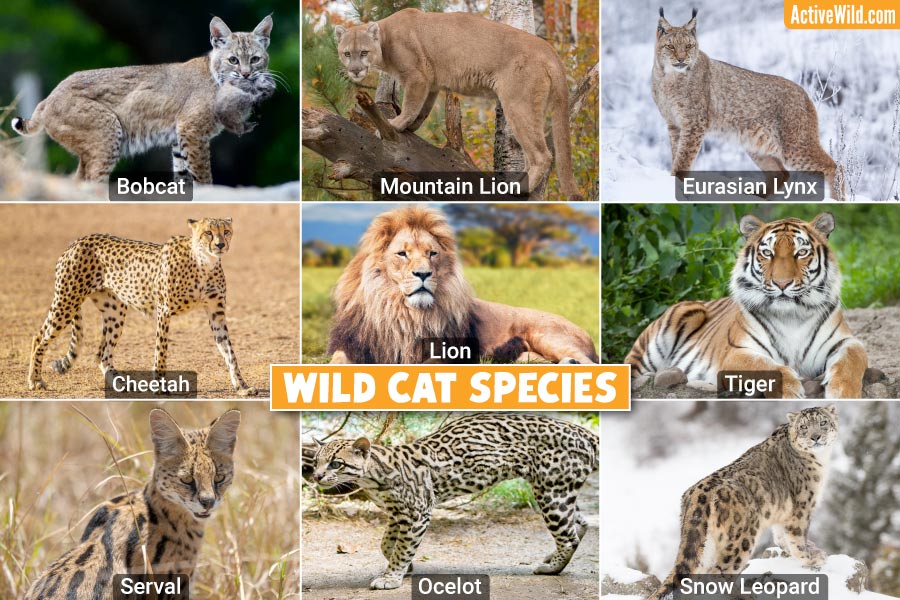
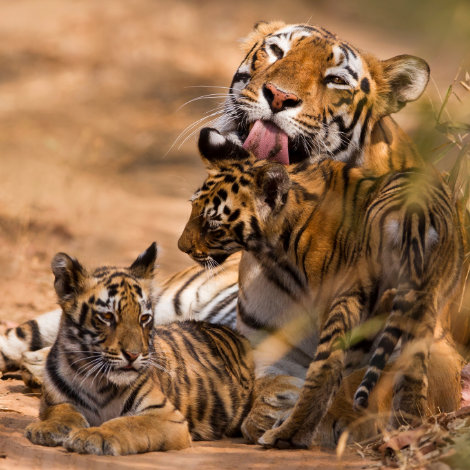
We have a small variety of bobcat it visits on occasion to hunt, we have rabbits, mice, squirrels and groundhogs. It loves our yard. It never bothers us. It shows up randomly and does its thing. I saw it today around 4 pm. It was walking confidently on our deck. Then realized we were in the driveway, and disappeared quickly around the back of the house. The thing that confuses me is its size. It’s small, like a very husky house cat, just a little bit bigger but not by much. Stocky legs, saggy fur at the belly, wider face, tabby stripes not spots so much. The tail is fat and about 4-5 inches long, sticks out in back as the cat flees. I’ve not seen enough bobcats to know, but this one seems kinda small. Is it a species thing? Or a juvenile? The saggy fur around the belly has me thinking it’s full grown. My husband thought it was just a stocky tabby cat, he’s crossed paths wit it 3 times. I’ve seen it twice, but sense it’s presence more often than I see it. I’m not calling the wildlife people, they kill everything they catch here, including our bears. They can’t be trusted to relocate any animal.
Hi Kim,
There is a small overlap in size between a small female bobcat and a large male house cat. With its short tail, it does sound like your visitor could be a bobcat. Unfortunately, a bobcat’s ear tufts are quite difficult to spot, but they would provide additional confirmation. Perhaps a trail cam could help you capture more evidence?
Thank you for your interesting message.
Regards,
The Active Wild Team
We live near Nashville and I have seen one twice…………
Today I saw a smallish cat brown/tan with no obvious coat markings with black feet and ankles, a bobbed black tail and white spots on the back ear tips. He was hunting a rabbit which was about 1/3rd his size. In Kentucky we have bobcats, but none of the photos show such a combination. Does anyone have an identity for this cat?
I believe it is a lynx with large black feet. Except for the black feet it appears to be a lynx.
Hi Nancy,
Thank you for your comments. From your initial description we’d have said that the cat you saw was likely a bobcat.
Bobcats do have white spots on the back of their ears, and perhaps its feet were muddy or wet? We’ve found a number of images of bobcats with black tail-tips online. From your location we would have thought that a Canada lynx would have been unlikely.
If any other readers have any information then feel free to comment!
Thank you again for your comment, it’s always good to hear about wild cat sightings!
Regards,
The Active Wild Team
Bobcat with atypical markings. White earspots and size, location, are key.
Crossing the Road ahead of me was a ‘thing’ I thought bobcat but then saw tail, and it’s black, possibly some brown. I slow looked at it. Maybe it was hot and thirsty? Seemed strong. And the tail. I knew it wasn’t a Bobcat. SW Georgia—Rural.
Thank you for sharing your observation. Without further information it’s difficult to say what species you saw. Depending on size, it may even have been a large, feral housecat. A mountain lion would have been highly unlikely in Georgia.
Hopefully you’ll see it again and get some more clues!
Regards,
The Active Wild Team
I live in Tn and have seen a cougar/mountain lion twice in my thirty 39 years living here. I thought I was seeing things BUT nope thats what it was. I was close enough to “see” the marking on its face. When I first saw the first one, the things my eyes fixated on was its tail. I saw it and fleeting thought said cat then no way and then the eyes went straight to its tail! It was as long if not longer then the body. The 2nd time I saw one I knew right away. Some say they arent here BUT I know what I saw…
Our neighbors game camera shot a picture of what seems to be a puma in our wooded neighborhood of Eastern Tennessee. It was seen at night, and is very large and long, but has faded markings on it’s upper legs and white spots on the back of its ears. Aside from that, it seems to have uniform coat color. It has a very long and heavy tail. In all the descriptions I’ve read for Pumas or mountain lions, I’m not seeing anything about white spots on the back of their ears. Could it be a youngster? It is NOT the size or shape of a bobcat.
Hello, and thank you for your interesting comment.
As you probably know, mountain lion sightings in Tennessee are extremely rare.
However, they do occur from time to time. (See this page for examples: https://www.tn.gov/content/tn/twra/wildlife/mammals/large/cougars.html#sightings)
We also haven’t found any mountain lion descriptions that mention white spots on the back of the ears.
We did an image search to see if we could find any evidence of this feature, and it appears that a few mountain lions do seem to have paler patches on the back of the ears – although it’s difficult to tell as most photos are taken from the front.
(You could try doing a similar search using Google / DuckDuckGo / Bing / etc. to compare photos.)
Perhaps the night photo exaggerated these and the other markings?
A long tail on a very large feline would certainly suggest a mountain lion over a bobcat (although once again, a trail cam photo taken at night can distort size, etc.)
Sorry we can’t really shed any light on this mystery. Perhaps your neighbor could forward their footage to the Tennessee Wildlife Resources Agency or local USFWS office?
If any of our other readers have knowledge / experience of mountain lions in Tennessee then please feel free to pitch in!
Regards,
The Active Wild Team
OOPS JUST saw that someone else said they have seen one. Maybe they ARE MORE COMMON THEN ONE THINKS. I have only had two people tell me they have seen one also.
My sister had smaller acreage property in northeastern Tennessee (northeast of Knoxville). Over the years she has had mountain lion activity. While not a frequent occurrence, it doesn’t seem to be uncommon
I have many pics of what looks to me just like that European mountain cat, and he recently adopted us. (We’re in central Texas). He’s a gentle giant, huge, w a bob cat looking face, light green eyes, thick ringed tail, white points under nose, and just loves to be petted. We saw him around our property from a distance for awhile, and thought he was a racoon. He then got closer and after some talking to, now acts just like a cat. Not sure where to send photos, but would like your opinion.
Hi Anya,
We suspect that your cat is a stray domestic cat, as it’s unlikely a wild species would readily approach and become tamed in such a way.
We’re based in England, but if you suspect that it is a wild species, perhaps you could get in touch with your local USFWS office, who may be able to help?
Wild cat or not, we hope that you’re enjoying the company of your new friend!
Regards,
The Active Wild Team
We saw a cat just like what you all have described and we were along Bear River State Park In Evanston, WY today. We were trying to figure out what we saw and cannot come up with what type of cat it is.
Which are the top 10 strongest wild cats?
Interesting question! It would probably go in order of size, with tigers, lions and jaguars being the strongest.
I live in Ma. Right near VT. I saw a mountain lion with my family in VT. When we went for a ride on a back road early evening. I know may people that see them in VT. People have hit them with their cars and they die. But if you ask officials we don’t have any mountain lions. I wonder how long before they Will admit the truth? Who knows?
… interesting, thank you for sharing.
I’m trying to figure out what kind of wild cat I saw. It was about the size of a medium dog, had a larger head than a normal cat, and a long tail that was ringed. Just a large feral cat or what? My dad described it perfectly and said it was a ring-tailed cat, but the pictures online look nothing like that. I’m very confused. In western Washington state. Thanks1
Could have been a young cougar (mountain lion)? I know they live in Washington State forests.
It sounds like you are describing a coatimundi.
We used to see them in the desert in Arizona all the time. Not so much anymore.
At a glance, in the wild, they can closely resemble a ring-tailed cat.
Many thanks for this interesting reply. It would be very far north for a wild coati, but it may have been an escaped pet.
Other readers can see what a coatimundi looks like on this page: Coatimundi Facts.
The Active Wild Team
I too have seen an animal as described by Megan Anastacio and MC Bach; I live in North Central Idaho. I would say it most closely resembles the European Wildcat image posted on this page. I wonder if it is commonly known whether domestic cats in the US can begin to display some of their ‘wilder’ looking phenotypic traits upon going feral/wild since they originated from wildcat ancestors??? The animal I’ve seen has a somewhat bushy and distinctly ringed tail w/ a blunt tip. This animal also appears to be solitary in nature. I live in a forested area w/ relatively low population density, and we do not have any feral cat colonies around. Does this just sound like a domestic cat gone wild???
I just saw exactly what you described. I’m in the Cascades in WA state and at first I thought it was the raccoon that visits nightly, but it was a bit smaller, still very thick fur, but more tabby colored with rings on it’s tail. It had the face of a house cat, but it’s mid-winter with snow and I can’t believe a house cat would have been able to survive this many months. Couldn’t find anything online that looked exactly like it except maybe the Chinese Mountain Cat, which I can’t believe it could be.
I very clearly saw something like that last night. The only thing I found online that looks the exact same is. European Wild Cat, but we are also in Washington State. We saw it at night near Kelso. It was much larger than a house cat, defined ringed tail, seemed a little bushy.
I just saw that type of cat across the street! I thought at first it might be a racoon as well. I’m on here trying to identify it. I am in Oregon City, which is northern Oregon.
I live in Grants Pass Oregon United States of America. I was traveling along the side of the Rogue River just after I left the Graves Creek bridge boat landing. I saw a black cat with ring tail cat was all black ring tail was gray/silver but the cat was so black at first I thought it was a shadow of a cat. But then it turned and be looked at me. I have no idea what kind of cat it was but had to be a wild as I was pretty far from any houses. It was beautiful and it’s tail was so much more bigger around than a domesticated cat and the rings of his tail was bright silver or gray maybe off white but not bright white but next to the black it was distinctly a ring tail. It was an amazing sight to see that’s for sure.
Where is the Scottish Wildcat, (Felis silvestris silvestris syn. Felis silvestris grampia)?
Why are there so few European wild cats? Were they all hunted to death?
Hi Sandra,
Great questions! The Scottish wildcat is a subspecies of European wildcat (which, incidentally, is why its scientific name has three parts; the third part denotes the subspecies).
Many cat species have subspecies; there wouldn’t be enough space for us to list them all!
The lack of wild cat species in Europe is probably explained in part by physical factors such as climate and geography, but I suspect most of all by habitat loss and persecution. Lions, leopards and probably tigers and several other wild cat species were once present in Europe, unfortunately no longer.
Thanks again for your questions,
The Active Wild Team